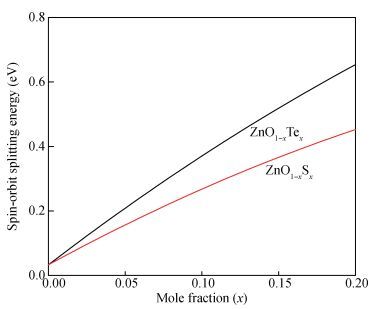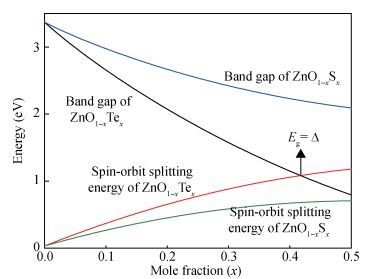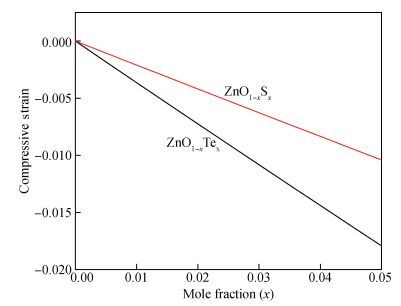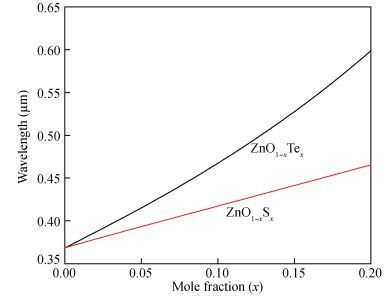| Citation: |
Utsa Das, Partha P. Pal. ZnO1-xTex and ZnO1-xSx semiconductor alloys as competent materials for opto-electronic and solar cell applications:a comparative analysis[J]. Journal of Semiconductors, 2017, 38(8): 082001. doi: 10.1088/1674-4926/38/8/082001
****
U Das, P P Pal. ZnO1-xTex and ZnO1-xSx semiconductor alloys as competent materials for opto-electronic and solar cell applications:a comparative analysis[J]. J. Semicond., 2017, 38(8): 082001. doi: 10.1088/1674-4926/38/8/082001.
|
ZnO1-xTex and ZnO1-xSx semiconductor alloys as competent materials for opto-electronic and solar cell applications:a comparative analysis
DOI: 10.1088/1674-4926/38/8/082001
More Information
-
Abstract
ZnO1-xTex ternary alloys have great potential to work as a photovoltaic (PV) absorber in solar cells. ZnO1-xSx is also a ZnO based alloy that have uses in solar cells. In this paper we report the comparative study of various parameters of ZnO1-xTex and ZnO1-xSx for selecting it to be a competent material for solar cell applications. The parameters are mainly being calculated using the well-known VCA (virtual crystal approximation) and VBAC (Valence Band Anti-Crossing) model. It was certainly being analysed that the incorporation of Te atoms produces a high band gap lower than S atoms in the host ZnO material. The spin-orbit splitting energy value of ZnO1-xTex was found to be higher than that of ZnO1-xSx. Beside this, the strain effects are also higher in ZnO1-xTex than ZnO1-xSx. The remarkable notifying result which the paper is reporting is that at a higher percentage of Te atoms in ZnO1-xTex, the spin-orbit splitting energy value rises above the band gap value, which signifies a very less internal carrier recombination that decreases the leakage current and increases the efficiency of the solar cell. Moreover, it also covers a wide wavelength range compared to ZnO1-xSx. -
References
[1] Weł na M, Kudrawiec R, Nabetani Y. Effects of a semiconductor matrix on the band anticrossing in dilute group Ⅱ-Ⅵ oxides. Semicond Sci Technol, 2015, 30:085018 doi: 10.1088/0268-1242/30/8/085018[2] He Y B, Zhang L, Wang L H, et al. Structural and optical properties of single-phase ZnO1-xSx alloy films epitaxially grown by pulsed laser deposition. J Alloys Compounds, 2014, 587:369 doi: 10.1016/j.jallcom.2013.10.201[3] Ramanathan S, Patibandla S, Bandyopadhyay S, et al. Fluorescence and infrared spectroscopy of electrochemically self assembled ZnO nanowires:evidence of the quantum confined Stark effect. J Mater Sci:Mater Electron, 2006, 17:651 doi: 10.1007/s10854-006-0021-4[4] Jaquez M, Yu K M, Ting M, et al. Growth and characterization of ZnO1-xSx highly mismatched alloys over the entire composition. J Appl Phys, 2015, 118:215702 doi: 10.1063/1.4936551[5] Gonfa B A, da Cunha A F, Timmons A B. ZnO nanostructures for photovoltaic cells. Phys Stat Solidi B, 2010, 247:1633 doi: 10.1002/pssb.v247:7[6] Gondek E, Djaoued Y, Priya S, et al. Organic hybrid solar cells——influence of ZnO nanoparticles on the photovoltaic efficiency. Mater Lett, 2014, 131:259 doi: 10.1016/j.matlet.2014.06.007[7] Ting M, dos Reis R, Jaquez M, et al. Electronic band structure of ZnO-rich highly mismatched ZnO1-xTex alloys. Appl Phys Lett, 2015, 106:092101 doi: 10.1063/1.4913840[8] Wang W, Bowen W, Spanninga S, et al. Optical characteristics of ZnTeO thin films synthesized by pulsed laser deposition and molecular beam epitaxy. J Electron Mater, 2009, 38:119 doi: 10.1007/s11664-008-0577-2[9] Nabetani Y, Okuno T, Aoki K, et al. Photoluminescence properties of ZnTeO and ZnSeO alloys with dilute O concentrations. Phys Status Solidi C, 2006, 3:1078 doi: 10.1002/(ISSN)1610-1642[10] Lin A S, Wang W, Phillips J D. Model for intermediate band solar cells incorporating carrier transport and recombination. J Appl Phys, 2009, 105:064512 doi: 10.1063/1.3093962[11] Wang W, Lin A S, Phillips J D, et al. Generation and recombination rates at ZnTe:O intermediate band states. Appl Phys Lett, 2009, 95:261107 doi: 10.1063/1.3274131[12] Thankalekshmi R R, Rastogi A C. Structure and optical band gap of ZnO1-xSx thin films synthesized by chemical spray pyrolysis for application in solar cells. J Appl Phys, 2012, 112:063708 doi: 10.1063/1.4754014[13] Meyer B K, Polity A, Farangis B, et al. Structural properties and bandgap bowing of ZnO1-xSx thin films deposited by reactive sputtering. Appl Phys Lett, 2004, 85:4929 doi: 10.1063/1.1825053[14] Wu J Q, Walukiewicz W, Yu K M, et al. Origin of large band-gap bowing in highly mismatched semiconductor alloys. Phys Rev B, 2003, 67:035207 doi: 10.1103/PhysRevB.67.035207[15] Walukiewicz W, Shan W, Yu K M, et al. Interaction of localised electronic states with conduction band:band anti-crossing in Ⅱ-Ⅵ semiconductor ternaries. Phys Rev Lett, 2000, 85:7[16] Alberi J, Blacksberg, Bell L D, et al. Band anticrossing in highly mismatched Sn_xGe1-x semiconductor alloys. Phys Rev B, 2008, 77:073202 doi: 10.1103/PhysRevB.77.073202[17] Iribarren A, Fernández P, Piqueras J. Recombination processes in Te-doped ZnO microstructures. Phys Status Solidi B, 2014, 251:683 doi: 10.1002/pssb.201248600[18] Vegard L. The constitution of the mixed crystals and the room filling the atoms. Z Phys, 1921, 5:17 doi: 10.1007/BF01349680[19] Gai Y Q, Tang G. Effects of hydrostatic pressures on the ionization and formation energies of dopants in ZnO and ZnTe. Phys Lett A, 2014, 378:82 doi: 10.1016/j.physleta.2013.10.041[20] Janetzko F, Jug K. Miscibility of zinc chalcogenides. J Phys Chem A, 2004, 108:5449 doi: 10.1021/jp040061+[21] Ashrafi A, Jagadish C. Review of zincblende ZnO:stability of metastable ZnO phases. J Appl Phys, 2007, 102:071101 doi: 10.1063/1.2787957[22] Samajdar D P, Das T D, Dhar S. Valence band anticrossing for Ga Sb1-xBix and Ga Sb1-xBix using k. p method. Mater Sci Semicond Process, 2015, 40: 539[23] Niv A, Abrams Z R, Gharghi M, et al. Overcoming the bandgap limitation on solar cell materials. Appl Phys Lett, 2012, 100:083901 doi: 10.1063/1.3682101[24] Sweeney S J, Jin S R. Bismide-nitride alloys:promising for efficient light emitting devices in the near-and mid-infrared. J Appl Phys, 2013, 113:043110 doi: 10.1063/1.4789624 -
Proportional views






 DownLoad:
DownLoad:





















